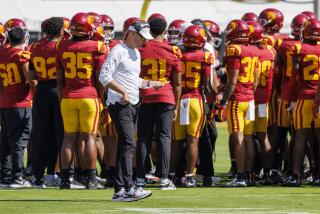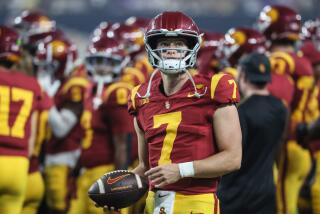Trojans Want a Ground Breaker
- Share via
TUCSON — Freshman C.J. Gable got a chance.
So did freshman Emmanuel Moody.
After starting them at tailback in its first two games, USC may turn to junior Chauncey Washington today in the Pacific 10 Conference opener against Arizona.
Regardless of who gets the ball first though, the third-ranked Trojans are seeking more than simply a victory against the Wildcats.
The Trojans are searching for a dominant running game.
“We know we have to have it working,” offensive coordinator Lane Kiffin said. “The last thing we want is to be a finesse, throw-the-ball-around offense.”
No one expected USC’s rushing attack to pick up where it left off when Heisman Trophy winner Reggie Bush and LenDale White left for the NFL after their junior seasons.
But USC’s tailback by committee, although productive in spurts, has struggled to establish a rhythm and break off big plays.
In 2005, the Trojans averaged 260 yards rushing a game and 6.4 yards a rushing play. They are averaging 167 a game and 4.6 a play this season. Moody’s 26-yard run last week in the fourth quarter against Nebraska is USC’s longest from scrimmage.
Asked if he were averse to mainly playing one tailback, USC Coach Pete Carroll said, “No. Not at all. We’re wide open. We’re working with the guys we have and finding out how much they need to get the ball and what happens when they get it more.”
In 2002, seeking an aggressive attitude as well as performance, Carroll turned to tailback Justin Fargas in the eighth game. Fargas’ first start coincided with quarterback Carson Palmer’s drive to the Heisman.
The next season, after losing their Pac-10 opener at California, the Trojans put the ball in White’s hands 21 times against Arizona State. On that day, USC began a 34-game, three-season winning streak, highlighted by the emergence of Bush, quarterback Matt Leinart and receiver Dwayne Jarrett, among others.
Carries were almost evenly distributed last season, Bush finishing with 200, White 197.
Kiffin, however, said USC was not tied to doing it the same way.
“It doesn’t have to fit the blueprint of a big guy and a little guy,” he said. “If it [going mainly with one tailback] ends up being the way it works, we have no problem doing that. We’re going to get the playmakers the ball.”
USC (2-0) hopes one or more will emerge against an Arizona team aiming to end the Trojans’ 23-game Pac-10 winning streak.
USC has not lost to a conference opponent since the 2003 defeat by Cal. But the Trojans have struggled in their first Pac-10 road game in each of Carroll’s five previous seasons.
Consider that USC:
* Lost at Oregon, 24-22, on a late field goal in 2001.
* Lost in overtime at Washington State, 30-27, in 2002.
* Lost to Cal, 34-31, in 2003.
* Trailed Stanford by 11 points at halftime before rallying to win, 31-28, in 2004.
* Trailed Oregon by 13 points late in the first half before scoring 45 unanswered points last season.
“I don’t have any idea about why that is,” Carroll said testily when a reporter asked about the pattern.
Senior flanker Steve Smith offered a theory, citing the Trojans’ last two conference road openers. “I think maybe we were feeling too comfortable, thinking the offense was going to come together,” he said. “This year, we want to get off to a fast start and eliminate that factor.”
Arizona (2-1), under third-year Coach Mike Stoops, hopes to slow the Trojans.
Last season at the Coliseum, Arizona trailed USC, 14-7, at halftime and 28-21 at the end of the third quarter. The Trojans gained 724 yards and had 39 first downs but committed two turnovers and needed a fourth-quarter interception to stave off the Wildcats in a 42-21 victory.
The Wildcats began this season by defeating Brigham Young. They were routed at Louisiana State then rebounded with a victory over Division I-AA Stephen F. Austin last week.
Arizona ranks fifth in the Pac-10 in total defense and last or next-to-last in every major category on offense.
Sophomore quarterback Willie Tuitama, who suffered a concussion against LSU, played in the second half last week and is expected to challenge USC’s young, untested secondary.
Junior college transfer Chris Jennings rushed for 201 yards and two touchdowns last week.
But the Trojans, like LSU, are a major step up for the Wildcats.
“You have to find some big plays somewhere along the line,” Stoops said. “We have to pick and choose our spots and make sure we can protect the quarterback as well because they don’t give you a whole lot of time.”
More to Read
Fight on! Are you a true Trojans fan?
Get our Times of Troy newsletter for USC insights, news and much more.
You may occasionally receive promotional content from the Los Angeles Times.






